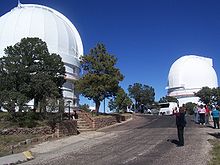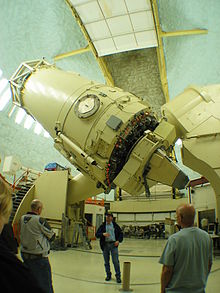- McDonald Observatory
-
 Dome of the 9.2 m Hobby-Eberly Telescope. It houses one of the largest optical telescopes in the world.
Dome of the 9.2 m Hobby-Eberly Telescope. It houses one of the largest optical telescopes in the world.
The McDonald Observatory is an astronomical observatory located near the unincorporated community of Fort Davis in Jeff Davis County, Texas, United States. The facility is located on Mount Fowlkes and Mount Locke in the Davis Mountains of West Texas.[1] The site is campus property of the University of Texas at Austin and receives its main funding from the university.
Contents
Observatory
The observatory is equipped with a wide range of instrumentation for imaging and spectroscopy in the optical and infrared spectra and operates the first lunar laser ranging station. McDonald works closely with the astronomy department of the University of Texas at Austin while maintaining administrative autonomy. The McDonald Observatory also produces and consults on StarDate, a daily syndicated radio astronomy segment hosted by Sandy Wood that airs on stations throughout the United States in both English and Spanish.
The Otto Struve Telescope and the Harlan J. Smith Telescope are located on Mount Locke at an altitude of 6,791 ft/2,070 m. The summit of Mount Locke is the highest point on Texas highways.[2] The Hobby-Eberly Telescope, dedicated in late 1997, is located on the summit of Mount Fowlkes at 6,659 ft/2,030 m above sea level. The high and dry peaks of the Davis Mountains make for some of the darkest and clearest night skies in the region and provide excellent conditions for astronomical research.
Currently, the observatory operates four research telescopes at its West Texas site:
- 9.2 m (360") Hobby-Eberly Telescope
- 2.7 m (107") Harlan J. Smith Telescope
- 2.1 m (82") Otto Struve Telescope
- 0.8 m (30") large format imaging telescope
A 0.9 m (36") telescope, formerly used for research, is now used for visitor programs.
Visiting
The Frank N. Bash Visitors Center includes a café, gift shop, and interactive exhibit hall. The Visitors Center also conducts daily live solar viewings in a large theater and tours of the observatory's largest telescopes. The most popular programs are the evening star parties, which allow visitors to look through large telescopes in the Telescope Park and enjoy an indoor program as well.
Special viewing nights, during which visitors can stay onsite and view directly through eyepieces on the 0.9 m, 2.1 m or 2.7 m telescopes, are held on a reservation-only basis. Programs on the two larger telescopes also include dinner. Check the Visitors Center website for availability.
History
The McDonald Observatory was originally endowed by the Texas banker William Johnson McDonald (1844–1926), who left $800,000(the bulk of his fortune) to the University of Texas to endow an astronomical observatory. The provision of the will was challenged by McDonald's relatives, and after a long legal fight, construction began at Mount Locke. The 2.1 m telescope was dedicated on May 5, 1939, and at that time was the second largest telescope in the world. McDonald Observatory was operated under contract by the University of Chicago until the 1960s, when control was transferred to the University of Texas at Austin under the direction of Harlan J. Smith.
The observatory now is home for the Hobby-Eberly Telescope, operated jointly by the University of Texas at Austin, Pennsylvania State University, Stanford University, Ludwig Maximilians University of Munich, and Georg-August University of Göttingen. The HET now ranks as the fourth largest telescope in the world, its cost being about 20% that of other similarly-sized telescopes in use today.
Research today at the McDonald Observatory encompasses a wide variety of topics and projects, including planetary systems, stars and stellar spectroscopy, the interstellar medium, extragalactic astronomy, and theoretical astronomy.
The observatory also hosts one of the four globally networked Robotic Optical Transient Search Experiment (ROTSE) telescopes, and is one of the two Monitoring Network of Telescopes (MONET) sites (the other being at the South African Astronomical Observatory in Sutherland,[3] with a telescope by Halfmann Teleskoptechnik.
The observatory produces StarDate, a syndicated radio program consisting of short segments related to astronomy that airs on many Public Radio affiliates.
Gallery
See also
- List of observatories
- StarDate
References
- ^ "About." McDonald Observatory.
- ^ Dindinger, Peter. "The Highest Point on Texas Highways", Flickr, Texas, 25 August 2009. Retrieved on 16 February 2011.
- ^ "Welcome to MONET / Astronomie & Internet". University of Göttingen. http://monet.uni-goettingen.de/foswiki.
External links
- McDonald Observatory
- SLR Global Performance Report Card
- Frank N. Bash Visitors Center
- McDonald Observatory Clear Sky Chart Forecasts of observing conditions.
- StarDate Online
Coordinates: 30°40′17″N 104°01′21″W / 30.67139°N 104.0225°W
Categories:- Astronomical observatories in Texas
- Asteroid discoverers (observatories)
- Buildings and structures in Jeff Davis County, Texas
- University of Texas at Austin
- Visitor attractions in Jeff Davis County, Texas
Wikimedia Foundation. 2010.









